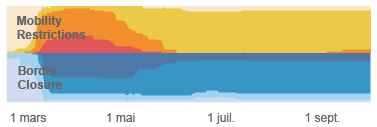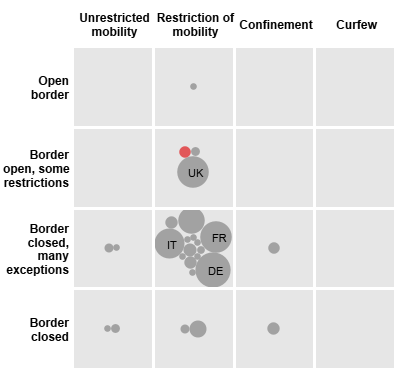Migration and Mobility in a Pandemic
Governments have significantly constrained human movement in response to the COVID-19 outbreak. Systematic information on which governments have taken which measures, and when, can help researchers understand whether measures regulating migration and mobility affect the rate of infection, and identify what factors drive governments’ decisions in this domain. Our datasets on Migration and Mobility in a Pandemic (MMP) allow to systematically track and compare public decisions to regulate human movement in response to the COVID-19 outbreak.
Description
MMP brings together two sets of publicly available information on the closure of the borders and restrictions to mobility. The starting date is 1 March 2020. The datasets allow users to explore the timing and the variation of government responses.
Map with the countries that have introduced travel restrictions (20 October 2020).
The first dataset covers the border control policies implemented by 204 countries globally in their attempt to limit the spread of COVID-19. It provides robust information on the countries that have introduced additional controls, the type of controls (self-isolation, in-depth screening, medical certificate, quarantine, no entry), what target countries, and exceptions granted (e.g. nationals, residents, humanitarian workers, official government missions, passengers in transit). The interactive visualization can be accessed through this link or by clicking on the images.

Growth in the number of countries that have introduced travel restrictions (20 October 2020).
We ask users to cite the dataset as follows: Andreas Perret, Jelena Dzankic, Lorenzo Piccoli. 2020. International Travel Restrictions in Response to the COVID-19 Outbreak, nccr – on the move.
Mobility and Border Controls in Response to the COVID-19 Outbreak
The second dataset correlates policies related to border control and policies related to the regulation of internal mobility by 29 countries in Europe. It provides information on the type of border control (open border; open border, with additional controls at the entry; border closed with generous exceptions to entry; border closed) and the policies related to the regulation of internal mobility (no restrictions; population invited to stay at home, schools closed; businesses and schools closed; curfews). The interactive visualization can be accessed through this link.
 Growth in the number of countries introducing restrictions on mobility and closure of the borders (20 October 2020).
Growth in the number of countries introducing restrictions on mobility and closure of the borders (20 October 2020).
 Different preferences for countries in the regulation of mobility and borders (20 October 2020).
Different preferences for countries in the regulation of mobility and borders (20 October 2020).
We ask users to cite the dataset as follows: Aurélie Pont, Christina Mittmasser, Frowin Rausis, Oliver Pedersen, Lorenzo Piccoli, Paula Hoffmeyer, Petra Sidler. 2020. Mobility and Border Control in Response to the COVID-19 Outbreak, nccr – on the move.
Data
Data is collected from public sources (websites of governments, newspapers, public databases) by a team of researchers from the nccr – on the move, in collaboration with GLOBALCIT at the European University Institute.
The datasets are provided free of charge. They can be obtained contacting Andreas Perret (andreas@perret@nccr-onthemove.ch). We ask that users acknowledge the source when using our data for their research and in their classes.
Please note that this is an ongoing collection of data. If you see any inaccuracies please contact us.
Usage
The MMP has been featured in two articles by Sara Goodman Wallace and Lorenzo Piccoli, both of which has appeared on the Washington Post. It has also been used in class by a number of teachers, including Julia Sardelic, Dejan Stjepanovic, and David Leblang.


